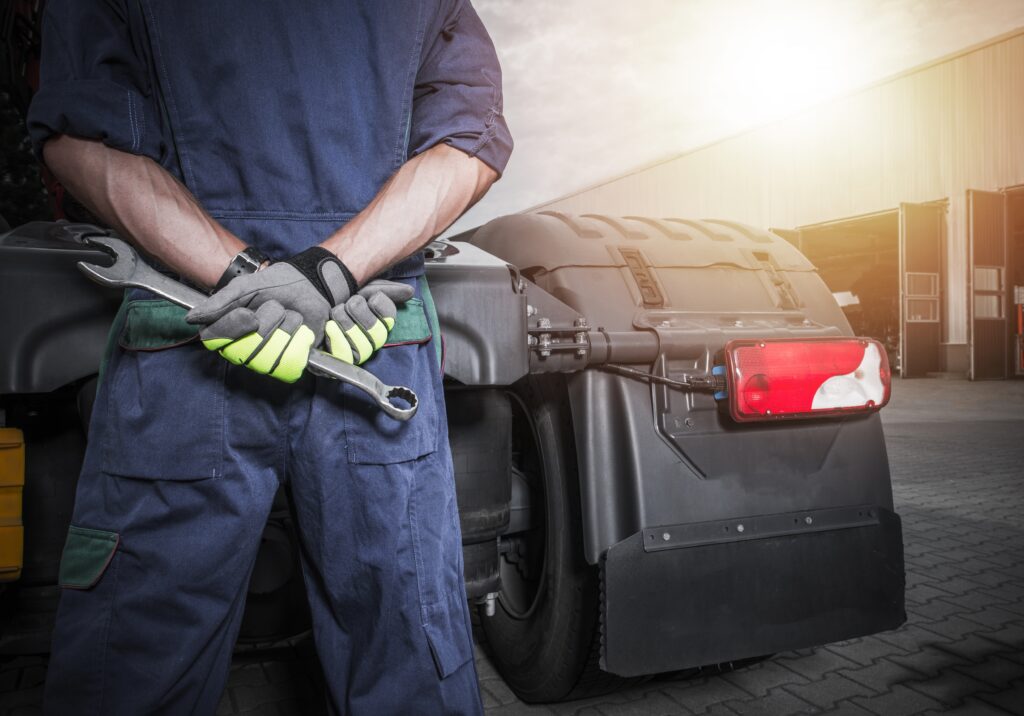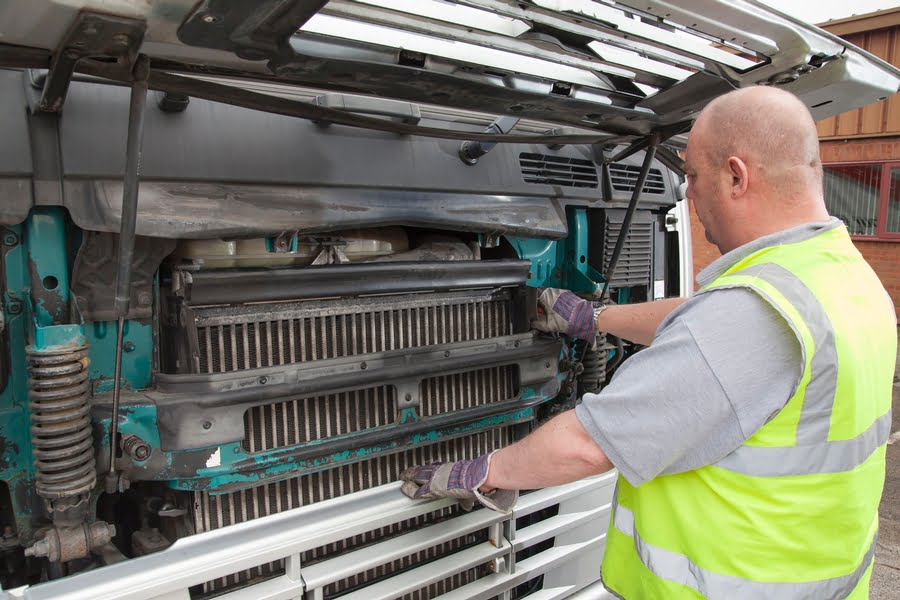The Show me, tell me Test
Drivers Responsibilities
Making sure your truck is roadworthy and safe to drive is a legally-binding aspect of being a driver.
The driver and the operator of the vehicle, are responsible for ensuring that daily/pre-use checks are carried out before any vehicle is used.
If your vehicle is not roadworthy, you could face a hefty fine, receive penalty points on your licence, or even face prison in the most serious cases.

All drivers must complete a defect report and a copy must be carried on the journey that they are undertaking…
If a fault is found, or the walk-around check criteria are not met, the faults must be reported using the defect report system. If any fault found is to such a degree that it renders the vehicle unroadworthy the driver must not use that vehicle until it has been repaired.
The following before-use checks are compulsory and must be carried out thoroughly by the driver:
1: Brake lines
We advise leaving the engine running (ensuring the parking brake is set)while you carry out your other checks, as pressure will build up and it will be easier to hear any leaks before you set off. If you hear continuous hissing, you know there’s a problem.
2: Security of load
It’s important to make sure the load you are carrying is safe and secure before you travel anywhere. You’re looking to see if the load is evenly distributed across the vehicle platform and that the vehicle is not leaning in any way. This could be seen by looking directly at the vehicle from the front. Another tell-tale sign is whether the suspension is sitting evenly or the mudguards are not resting on the tyres. You should also check any container you are carrying has a secondary locking device for added security. Loads may not normally project more than 305mm on either side of the vehicle trailer. The overall width of the vehicle and load must not normally exceed 2.9m if so then marker boards and other measures may be required.

3: Markers and registration plates
Make sure the marker boards, if required, and registration plates are in place, are securely fastened and of the correct type. Ensure they are clearly visible and not obscured by dirt or any other objects. Ensure that during the hours of sunset and sunrise they are adequately illuminated.
4: Tyres and wheel fixing
This is an important aspect of the checks, as you need to check as much of the tyre and wheel as you can see. You must ensure there are not any insecure or missing wheel nuts; that there is a minimum tread depth of 1mm across 75% of the width of the tyre but also around the whole circumference of the tyre; sufficient inflation in each tyre; that there are no deep cuts in the sidewall or cord visible anywhere on the tyre; that there are no bulges in the tyre wall. All tyres should be free from any defect which can endanger any members of the public, or any other road users or cause damage to the road surface.
5: Spray suppression
Suppression flaps should be fitted where they are required to be stiff, secure, undamaged and not clogged with mud or debris. Spray suppression is a legal requirement for all HGVs but not tippers, which are exempt.
6: Security of body/wings
The exterior of your truck is just as important as the interior. You should check all fastening devices are present, complete, secure and in good working order. Cab doors and trailer doors should be secure when closed and no body parts of the truck, tractor unit, or trailer, are loose or in danger of falling off while travelling. Also, check landing legs are not likely to fall. You should physically grab hold of the side guards and see if there is any movement there.

7: Electrical connections
Check all electrical switches of the truck operate their components correctly and that all visible wiring is insulated and is not likely to catch anything. All electrics should be working when you are in the cab.
8: Mirrors and glass
It’s vital to ensure you can see out of all of the mirrors you need to drive the vehicle safely. They should be secure and aligned properly, ensuring your view of the road is not obscured. You should also check the side windows are not damaged or discoloured, as this could affect your view of a mirror. Mirrors need to be fitted, clean and free from cracks. If they are muddy, or frosty, you need to get out and clean them. Windows should not be so tinted that your vision is obscured.
9: Horn
The horn should be easily accessible from your driver’s seat and it has to work when you need to access it. Before checking the horn drivers should ensure that there are no limitations on the operator’s licence as to when it can be used i.e. if the operator’s site is within or near a residential area.
10: Steering
Checks must be made for excessive play. During your checks for leaks underneath the vehicle, ensure the major steering components are in place and undamaged. Gentle pressure should be applied with the ignition on and you should easily be able to move the steering wheel with two fingers.

11: Brakes
Both the law and common sense demand brakes are properly adjusted and working efficiently at all times. When applicable, check the service break operates both the tractor and trailer brakes and that the parking brake for the tractor is operational. Listen for the air releasing from the tractor and the trailer, or ask a colleague to watch the trailer brakes operating as you press the pedal. You should feather the brakes in the first few metres of setting off and check to ensure they are working.
12: Excessive engine exhaust smoke
It is an offence if your vehicle emits excessive volumes of smoke, visible vapour, or any other substance likely to cause damage to a person or property. Since September 1995, tougher exhaust emission standards have been applied to trucks, buses and coaches. Local authorities now have the power to test vehicles at the roadside. Causing excessive smoke could contribute to causing an accident and mechanical defects could become dangerous if ignored. You could also end up causing traffic chaos if your vehicle breaks down in a difficult location. Blue smoke indicates you are burning oil, white smoke coolant and black smoke excessive fuel.
13: Windscreen wipers and washers
Wipers should move continually when switched on and they must clear the screen effectively when used with washers. Washers must point at the screen and be in full working order. Check the wiper blades are free from damage and are firmly secured to the wiper arm. Ensure that you have sufficient washer fluid in the reservoir.
14: Lights and indicators
Check all lights and indicators work correctly and lenses are clean, as well as working correctly. Stop lamps should come on when the brake is applied and go out when released. On vehicles over 7.5 tonnes and trailers over 3.5 tonnes gross weight, reflective markers must be fitted at the rear, and all dashboard warning lights should work correctly. Lights should be in good working order for both day and night time driving and they must be in the correct position. Drivers should check to ensure the truck reflectors are not broken, missing or of the wrong colour. In checking the lights you could get assistance from another driver.

15: Coupling security
If applicable, check the trailer is located correctly in the fifth wheel and the security bar is in the correct position for its use.
The uncoupling sequence:
B – Apply the trailer parking brake
L – Lower the landing legs and stow away the winding handle
A – Disconnect the airlines and electrical leads, and stow away
C – Lift the clip and (5th wheel)
K – Pull the kingpin
The coupling sequence:
K – Select a low forward gear and, with the trailer brakes still applied, slowly pull forward twice in order to test the kingpin has locked into place
C – Visually check the clip (5th wheel) has dropped into place
A – Connect the airlines and electrical leads
L – Wind up the landing legs and stow away the handle
B – Release the trailer parking brake
16: Seats/seat belts
Ensure all seat belts in the truck work correctly and are worn at all times when you are driving the vehicle. We call it the four S’s – seat, steering wheel, seatbelt and security.. Your arms should be in a 10 to 2 position and your arms should not be too far away from the steering wheel. You should feel comfortable, with a slight kink in your arms, as this is best for long-distance driving. It can lead to fatigue if you don’t sit correctly. The seat must be adjusted so as to ensure that you have full control and maximum visibility when you are driving the vehicle.
17: Fire extinguisher
This should be carried in your truck and checked regularly to make sure it is in date and full working order. Fire extinguishers are only compulsory if fitted to an ADR-certificated vehicle; however, checking them is good practice for every driver as they are there for your safety. At HGV Training we also offer ADR Training for those looking to increase their earning potential.
The following checks are not compulsory but advised if possible:
1: Fuel/oil leaks
While the engine is on, check underneath the vehicle for any leaks of fuel or oil, and the fuel filler cap is properly located. If you see a leak which isn’t fuel or oil, trace the cause, as this could be linked to power steering fluid or water.
2: Battery security/condition
Check the battery is held securely in place by the correct means, not by its cables, and it is not leaking. The battery must be replaced if it’s leaking.
3: First aid kit and emergency exit hammer
This should be kept in the truck and filled with basic first aid items. Items should be checked to ensure thay are in date. The hammer should also be kept close by in case you need to use it to exit the vehicle in the event of an accident.
4: Heating and ventilation
Check you are able to adjust the temperature inside the truck and the windows also work correctly.
And finally:
Drivers need to be aware that defects relating to Tyres, Brakes, Steering and Suspension carry not only fixed penalties but endorsements’ on the drivers licence which in turn will have an effect on their own personal insurance premiums.
At HGV Training Network we offer one-to-one tutition for HGV Training, CPC driver training, horsebox training and trailer training. Unlike most training providers we offer CPC training finance allowing you to train now and pay later on any of our courses. With over 40 locations nationwide there will always be a training centre convinient for you to attend. Learn more by giving us a call on 0800 254 5007 today.








